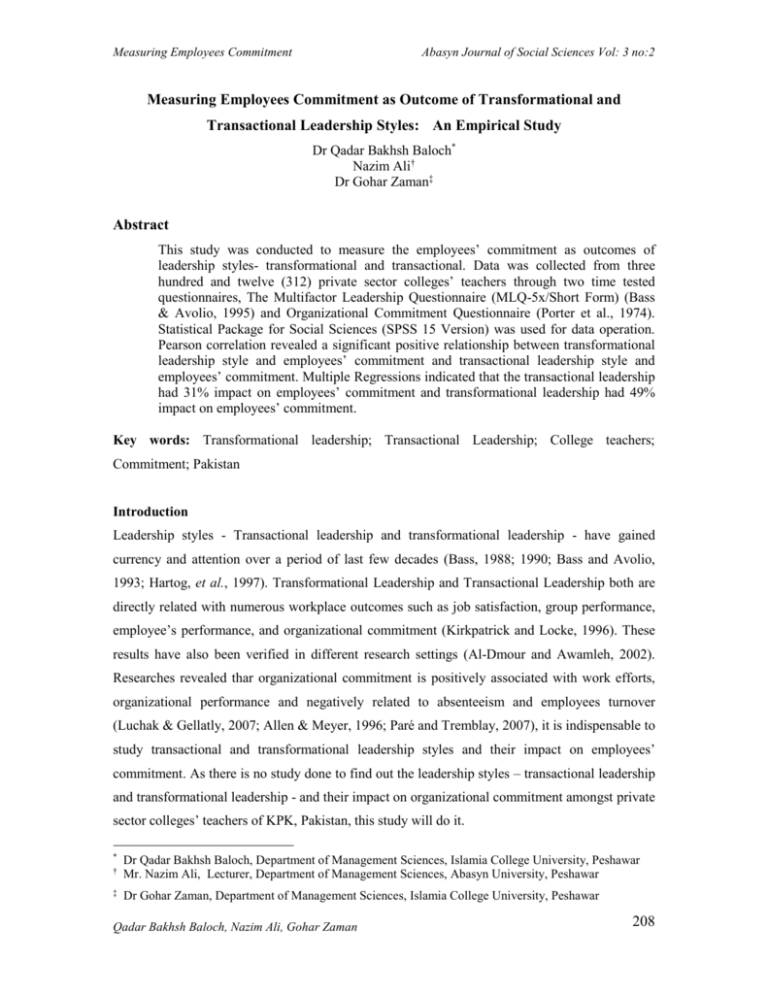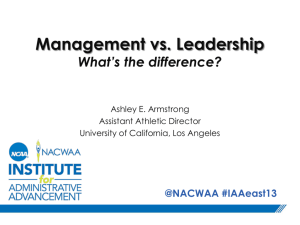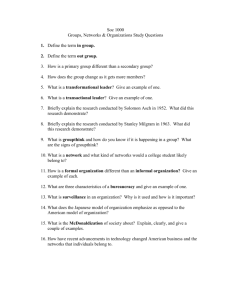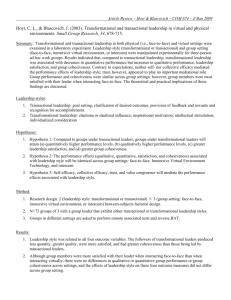Abstract - Abasyn Journal of Social Sciences
advertisement

Measuring Employees Commitment Abasyn Journal of Social Sciences Vol: 3 no:2 Measuring Employees Commitment as Outcome of Transformational and Transactional Leadership Styles: An Empirical Study Dr Qadar Bakhsh Baloch* Nazim Ali† Dr Gohar Zaman‡ Abstract This study was conducted to measure the employees’ commitment as outcomes of leadership styles- transformational and transactional. Data was collected from three hundred and twelve (312) private sector colleges’ teachers through two time tested questionnaires, The Multifactor Leadership Questionnaire (MLQ-5x/Short Form) (Bass & Avolio, 1995) and Organizational Commitment Questionnaire (Porter et al., 1974). Statistical Package for Social Sciences (SPSS 15 Version) was used for data operation. Pearson correlation revealed a significant positive relationship between transformational leadership style and employees’ commitment and transactional leadership style and employees’ commitment. Multiple Regressions indicated that the transactional leadership had 31% impact on employees’ commitment and transformational leadership had 49% impact on employees’ commitment. Key words: Transformational leadership; Transactional Leadership; College teachers; Commitment; Pakistan Introduction Leadership styles - Transactional leadership and transformational leadership - have gained currency and attention over a period of last few decades (Bass, 1988; 1990; Bass and Avolio, 1993; Hartog, et al., 1997). Transformational Leadership and Transactional Leadership both are directly related with numerous workplace outcomes such as job satisfaction, group performance, employee’s performance, and organizational commitment (Kirkpatrick and Locke, 1996). These results have also been verified in different research settings (Al-Dmour and Awamleh, 2002). Researches revealed thar organizational commitment is positively associated with work efforts, organizational performance and negatively related to absenteeism and employees turnover (Luchak & Gellatly, 2007; Allen & Meyer, 1996; Paré and Tremblay, 2007), it is indispensable to study transactional and transformational leadership styles and their impact on employees’ commitment. As there is no study done to find out the leadership styles – transactional leadership and transformational leadership - and their impact on organizational commitment amongst private sector colleges’ teachers of KPK, Pakistan, this study will do it. * † ‡ Dr Qadar Bakhsh Baloch, Department of Management Sciences, Islamia College University, Peshawar Mr. Nazim Ali, Lecturer, Department of Management Sciences, Abasyn University, Peshawar Dr Gohar Zaman, Department of Management Sciences, Islamia College University, Peshawar Qadar Bakhsh Baloch, Nazim Ali, Gohar Zaman 208 Measuring Employees Commitment Abasyn Journal of Social Sciences Vol: 3 no:2 Literature Review According to Burns (1978) there are two types of leadership styles, transformational leadership and transactional leadership. “Transformational leadership occurs when one or more persons engage with others in such a way that the leaders and followers raise one another to higher levels of motivation and morality” (Burns, 1978, p. 20). According to Marzano et al., (2005), fours I’s are important in the transformational development process. Idealized Influence Inspirational Motivation Intellectual Stimulation and Individual Consideration Idealized influence is also known as charisma. “Leaders are admired, respected, and trusted. Followers identify with and want to emulate their leaders” (Avolio & Bass, 2004). Bass and Avolio (1994) described inspirational motivation as: Transformational leaders behave in ways that motivate and inspire those around them by providing meaning and challenge to their followers’ work....The leaders creates clearly communicated expectations that followers want to meet and also demonstrates commitment to goals and shared visions. Yukl (2006) described intellectual stimulation as “behavior that arouses strong follower emotions and identification with the leader”. Bass and Avolio (1994) describe individual consideration as: Transformational leaders pay special attention to each individual’s needs for achievement and growth by acting as a coach or mentor. Followers and colleagues are developed to successively higher levels of potential....New learning opportunities are created along with a supportive climate. Individual differences in terms of needs and desires are recognized. The leader’s behavior demonstrates acceptance of individual differences. According to Burns (1978), “Transactional leadership occurs when one person takes the initiative in making contact with others for the purpose of an exchange of valued things”. According to Bass and Riggio (2006), “Transactional leaders are those who lead through social exchange”. Yukl (2006) described contingent reward as “…clarification of the work required obtaining rewards and the use of incentives and contingent rewards to influence behavior”. Managementby-exception focuses on leadership as a negative behavior. This leadership behavior is when the leader concentrates on the subordinates “deviances, mistakes, and errors and then taking corrective actions as quickly as possible when they occur” (Avolio & Bass, 2004). Relationship between Leadership Styles and Organizational Commitment Qadar Bakhsh Baloch, Nazim Ali, Gohar Zaman 209 Measuring Employees Commitment Abasyn Journal of Social Sciences Vol: 3 no:2 A plethora of research is available on the relationship between leadership styles and organizational commitment. Ibrahim et al (2010) found that there was a significant correlation between transactional and transformational and organizational commitment. Charles and Katherine (2007) also investigated a significant relationship between leadership stylestransformational and transactional- and commitment. Therefore it is hypothesized in this study that: H1: There is a significant relationship between transformational leadership style and organizational commitment H2: There is a significant relationship between transactional leadership style and organizational commitment Model Independent variables Dependent variable Transformational Leadership Style Employees’ Commitment Transactional Leadership Style Methodology : Four hundreds (450) questionnaires along with a covering letter that explained the purpose of the study were distributed to private sector colleges’ teachers of KPK. Three hundreds and nineteen (319) questionnaires indicating a response rate of 70.88% were returned. Only seven (7) questionnaires were disposed off because they contained incomplete information. Multifactor Leadership Questionnaire: Transformational and transactional leadership styles were measured by using The Multifactor Leadership Questionnaire (MLQ-5x/Short Form) (Bass Qadar Bakhsh Baloch, Nazim Ali, Gohar Zaman 210 Measuring Employees Commitment Abasyn Journal of Social Sciences Vol: 3 no:2 & Avolio, 1995). Transformational leadership style was measured by Four (4) subscales which are Charisma, Individualized Consideration, Inspirational Motivation, and Intellectual Stimulation. Transactional leadership style was measured by two (2) subscales which are Contingent Rewards, and Management-by-Exception. Responses were recorded on 5-point likert scale, 0 “not at all”, 1 “once in a while”, 2 “sometimes”, 3 “fairly often” and 4 “frequently, if not always”. Reliability of each subscale is shown in table 1. Table 1 Scales Items Reliability Charisma 4 .76 Individualized Consideration 4 .81 Inspirational Motivation 4 .79 Intellectual Stimulation 4 .83 Contingent Rewards 4 .86 Management-by-Exception 4 .85 Organizational Commitment Questionnaire: Fifteen (15) items from the questionnaire developed by Porter et al. (1974) were used to measure organizational commitment. The effects of Reverse coded questions were nullified by subtracting from 6. Responses were recorded on 5 point likert scale from 1 “Strongly Disagree” to 5 “Strongly Agree”. The scale = .75). Research Findings Table 2: Relationship between transformational Leadership and Employees’ commitment transformational Leadership Employees’ Commitment Pearson Correlation Sig. (2-tailed) N ** Correlation is significant at the 0.01 level (2-tailed). .539(**) .000 312 Table 2 indicates that there is a significant positive relationship between transformational leadership style and employees’ commitment. Therefore H1 which states that there is a significant Qadar Bakhsh Baloch, Nazim Ali, Gohar Zaman 211 Measuring Employees Commitment Abasyn Journal of Social Sciences Vol: 3 no:2 positive relationship between transformational leadership style and employees’ commitment is accepted in this study. Table 3: Relationship between Transactional Leadership and organizational commitment Transactional Leadership Commitment Pearson Correlation Sig. (2-tailed) N ** Correlation is significant at the 0.01 level (2-tailed). .613(**) .000 312 Table 3 indicates that there is a significant positive relationship between transactional leadership style and organizational commitment. Therefore H2 which states that there is a significant positive relationship between transactional leadership style and employees’ commitment is accepted in this study. Table 4: Model Summary R Adjusted Model R Square Square the Estimate 1 .471 .422 1.13659 .628(a) R Std. Error of F Sig. 31.648 .000 a Predictors: (Constant), Transactional Leadership, transformational Leadership Table 4 shows the coefficient of determination (R Square) which indicates that forty seven percent (47%) of the variance in employees’ commitment can be accounted for by Transactional Leadership and transformational Leadership styles. Table 5: Coefficients (a) Model 1 (Constant) Transformational Leadership Transactional Leadership Unstandardized Standardized Coefficients Coefficients t Sig. Beta B Std. Error 4.476 .000 B Std. Error 1.262 .326 .314 .087 .213 4.178 .012 .491 .167 .365 6.235 .000 a Dependent Variable: Employees’ Commitment Qadar Bakhsh Baloch, Nazim Ali, Gohar Zaman 212 Measuring Employees Commitment Abasyn Journal of Social Sciences Vol: 3 no:2 Table 5 indicates that Transformational Leadership has thirty one percent (31%) impact on employees’ commitment while Transactional Leadership 49% on employees’ commitment. The result also indicates that transactional leadership style is a stronger predictor of organizational commitment than transformational leadership style. Independent variables Dependent variable Transformational Leadership Style .31 Employees’ Commitment .49 Transactional Leadership Style Conclusion This study investigated the relationship between transactional leadership style and transformational leadership style and employees’ commitment. Data was collected from 312 private sector colleges’ teachers through two time tested questionnaires, The Multifactor Leadership Questionnaire (MLQ-5x/Short Form) (Bass & Avolio, 1995) and Organizational Commitment Questionnaire (Porter et al., 1974). Statistical Package for Social Sciences (SPSS 15 Version) was used for data operation. Correlation revealed a significant relationship between transformational leadership style and employees’ commitment and transactional leadership style and employees’ commitment. Multiple Regression revealed that transformational leadership style had thirty one percent impact on employees’ commitment and transactional leadership forty nine percent on employees’ commitment. References: Qadar Bakhsh Baloch, Nazim Ali, Gohar Zaman 213 Measuring Employees Commitment Abasyn Journal of Social Sciences Vol: 3 no:2 Allen, N.J.,& Meyer, J.P. (1996). Affective, continuance, and normative commitment to the organization: an examination of construct validity. Journal of Vocational Behavior, 49, 252-276. Awamleh, R., & Gardner, W. L. (1999). Perceptions of leader charisma and effectiveness: The effects of vision content, delivery, and organizational performance. Leadership Quarterly, 10(3):345-373. Bass, B.M., (1994), Transformational leadership and team and organizational decision making. Sage Thousand Oaks. CA. Bass, B.M., & Avolio, B., (1993), “Trans-formational leadership and organ-izational culture”. Public Administration Quarterly, 17, 112-21. Bass BM, Avolio BJ (1994). Improving organizational effectiveness through transformational leadership. California: Sage. Burns JM (1978). Leadership. New York: Harper & Row. Charles R. Emery, Katherine J. Barker (2007). “The effect of transactional and transformational leadership styles on the organizational commitment and job satisfaction of customer contact personnel”, Journal of Organizational Culture, Communications and Conflict. Hartog, D.N.D., Muijen J.J. & Koopman V., (1997), “Transactional vs. transformational leadership: an analysis of the MLQ”. Journal of Occupational and Organizational Psychology, 70: 19-34. Ibrahim S M, Nurzahit K and Türker B (2010). “Leadership Style and Organizational Commitment: Test of a Theory in Turkish Banking Sector” Journal of Academic Research in Economics, 2010, vol. 2 (1), pp 1-20 Leithwood, K. (1992). The move toward transformational leadership. Educational Leadership, 49 (5), 8-12. Luchak, A. A., & Gellatly, I. R. (2007). A comparison of linear and nonlinear relations between organizational commitment and work outcomes. Journal of Applied Psychology, 92 (3), 786-793. Paré, G., & Tremblay, M. (2007). The influence of high-involvement human resources practices, procedural justice, organizational commitment, and citizenship behaviors on information technology professionals’ turnover intentions. Group & Organization Management, 32 (3), 326357. Qadar Bakhsh Baloch, Nazim Ali, Gohar Zaman 214







